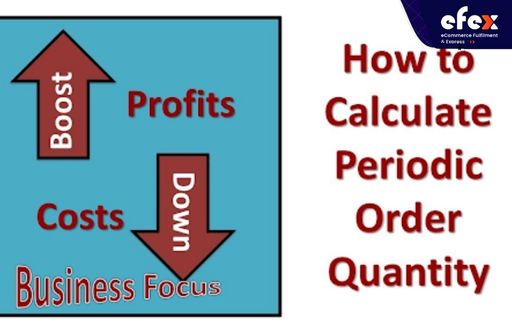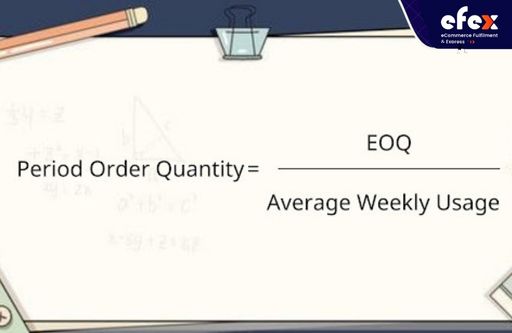
More Helpful Content
When making purchases for your company, it might be difficult to determine the amount you should order. While you don't want to run out of things, you also don't desire to maintain an excessive amount of inventory that ends up costing money and eating up space. You can overcome this difficulty by using a lot-sizing method called Period Order Quantity.
Using this method, you can decide how much of a specific product to purchase on a regular basis based on the demands and variations of your company while taking into account supply and demand. You can guarantee that you're constantly ordering the proper number of products for your company, eliminating waste, and working efficiently with Period Order Quantity.
In the long run, this will save you time and money and make your customer satisfied.

A lot-sizing strategy known as period order quantity requires that the lot size match the net requirements for a specific number of periods.
The period order quantity is, in other words, the standard number of units to be ordered over a predetermined period of time. When the use of supplies or raw materials is predictable and consistent, this method is used.
A master purchase order agreement allows the purchasing team to easily arrange for the delivery of certain amounts at predetermined intervals.
When using the many-sizing approach, the net requirements for a specific quantity of units, such as several weeks, are comparable to the per-unit size.
👉 Read More: What Is Planned Order Receipt? Calculation And Example
The estimated quantity to be stored is a variable, and as a result, so is the cost of ordering. The system is set up so that warehouse automation is used to address the challenges management faces while handling a high volume of orders.
This automation method is based on the concept of WIP. The surplus inventory is kept in warehouses, and any additional units that are purchased are immediately added to the manufacturing line. As long as this is consistently done, the issue of warehouse overstock can be resolved without disrupting the production process.
The costs of the raw materials or products that must be acquired and kept in the warehouse are determined by the manufacturing lot sizes in terms of the costing structure. The issue with handling these lot sizes is determining whether or not the pricing is consistent across all circumstances.

Production lot sizing is used to offer a solution for this issue. It entails determining the minimum and maximum quantities of orders that must be met for each product produced. The cost of labor, commodities and raw materials may all be determined once the overall cost of manufacturing has been determined.
Master production, as well as level term, are other phrases that describe POQ. The production expense is equivalent to the total of all prior sales, even those that have not yet been registered, in the master production, which corresponds to the present situation when no sales have been recorded.
The term "level" describes the present trend, which shows that the trend of sales is rising and occasionally exceeding the level. 3 master production levels—current, trend, and maximum order quantity—are specified.
👉 Read More: What is Level Production Strategy? Formula and Example
👉 Read More: What Is Time Fence Planning? Example And Benefit
The first refers to the present period in regards to production, whereas the latter specifies the maximum total units that may be created at any given time.
In POQ, EOQ is divided by average yearly demand to determine the optimal order cycle time. If the value is a fraction, round it up to the next higher integer. This span of time is known as POQ.

EOQ means Economic Order Quantity. This metric is the absolute amount of inventory that a company should purchase to satisfy demand while minimizing holding, shortfall, and order costs.
The following are some issues with the period order quantity concept:
Investing volume. A single delivery is often intended to endure for monthly or quarterly usage, which might lead to an overly high inventory amount being kept on hand. Management will need to utilize a more accurate ordering system, like a material needs planning or JIT system if it wants to lower the inventory expense. When the unit cost is low, this is less of a problem.
Demand variability. The risk of a stockout increases if the amount of demand for a product unexpectedly rises just before the end of a period of use. Employing some safety stock can remedy this problem, but doing so raises the cost of the inventory investment.
Demand termination. Even when consumption has decreased or stopped, the strategy can still lead to supplier delivery. The absence of a tracking system for such commodities is the issue. The problem can be handled by requiring the purchasing personnel to perform a routine visual inspection of the inventory on hand.
👉 Read More: What Is Quantity On Hand And Calculation?
For example, EOQ for an item is 3000 units and the annual usage is 48,000 units.
Average weekly usage = 48,000/ Average Weekly Usage
= 48,000/48 = 1000 units.
Now POQ = 3000/1000 = 3 weeks.
Then, an order covers the needs for three weeks when it is placed.
👉 Read More: What Are Gross Requirements? Plan And Calculation
In a nutshell, the period order quantity approach is a straightforward, low-facilitating method for ensuring that orders are placed regularly in roughly the right numbers. Its application should be restricted to products where there is a strong likelihood that demand will remain steady for a sizable amount of time.
However, it is important to remember that this method has several drawbacks, including the possibility of a higher risk of unavailable goods and the absence of tracking information for specific goods.
Overall, the benefits of period order quantity outweigh the disadvantages, making it a useful strategy for your company.


